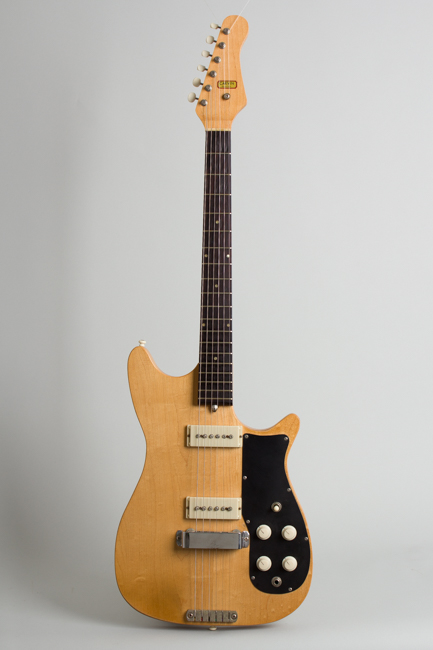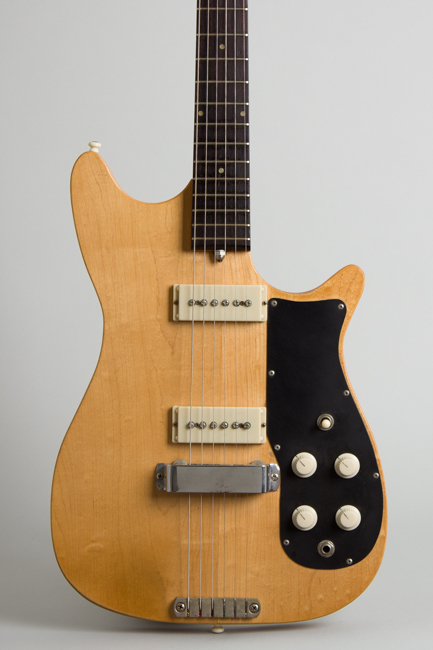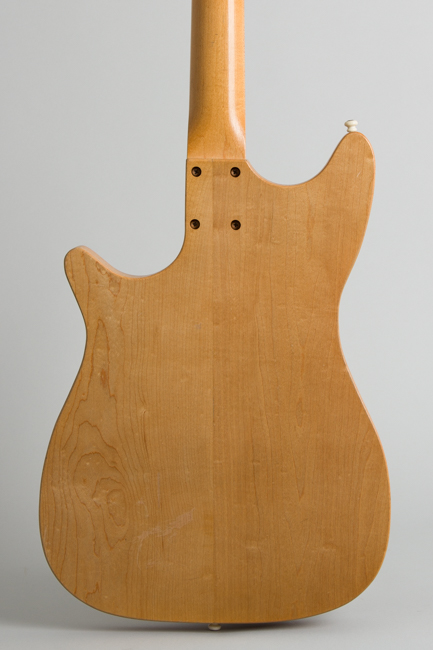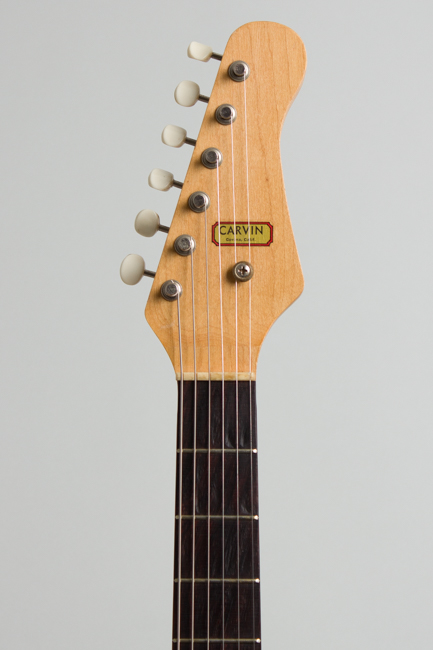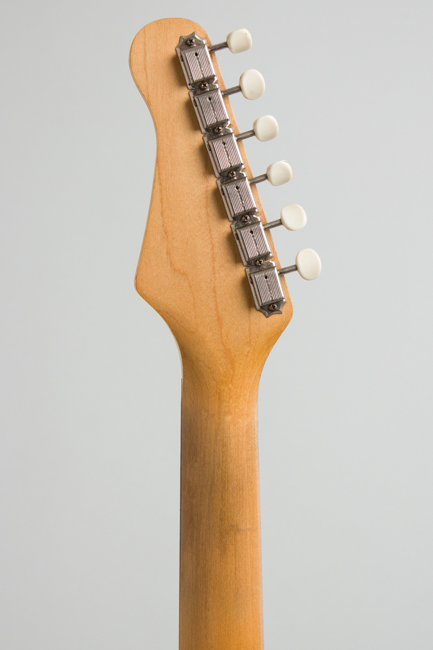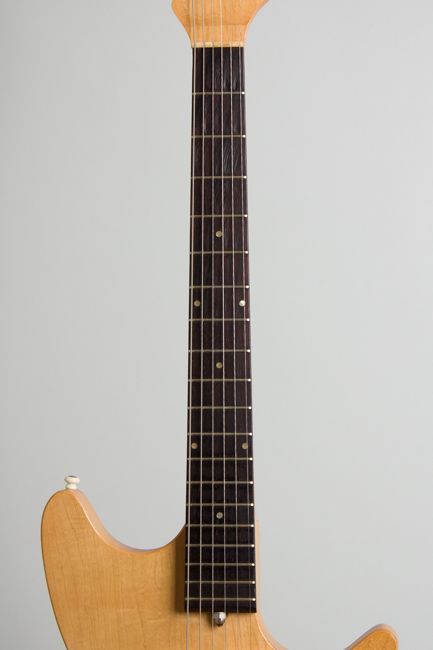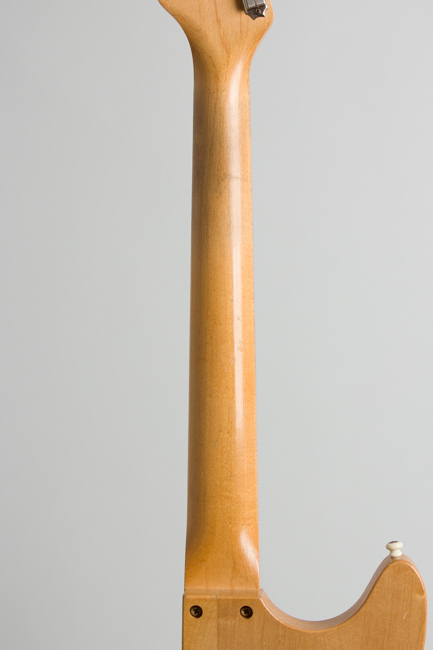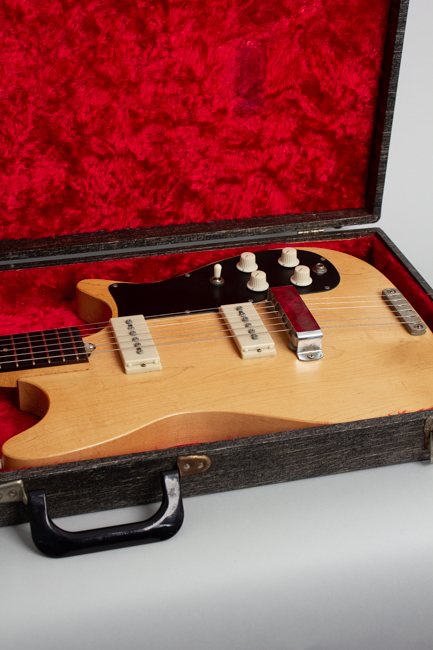Carvin #32-SGB Solid Body Electric Guitar (1962)
Carvin #32-SGB Model Solid Body Electric Guitar (1962), made in Covina, California, natural finish, maple body and neck, rosewood fingerboard, original black hard shell case.
This unassuming little solidbody is an interesting historical piece, a surprisingly fine guitar despite its rather homemade appearance! Carvin instruments are a product of the same Southern California spawning grounds as many electric guitar lines of the 20th century; Fender, Rickenbacker, National, Bigsby and Mosrite all emerged from the same general time and place.
The confluence of a lively, progressive hillbilly music scene, proximity to the entertainment colossus of Hollywood, and numerous untraditionally-minded craftsmen resulted in a radical re-thinking of the electric guitar, and the emergence of the solid body instrument as its ultimate form. While Carvin is not usually mentioned in connection with these other pioneers, the small California company was active from early on and is still an ongoing success.
Carvin founder Lowell Kiesel moved his fledgling steel guitar-building operation from Nebraska to California around 1948, and by 1950 had changed the name from Kiesel to Carvin, which combined his two sons' names. Carvin became famous for selling primarily electric instruments via mail order only, as well as being one of the few sources in the 1950s selling parts for do-it-yourself electric guitar tinkerers. Carvin's best remembered products of the era are the AP-6 pickups mounted on this guitar; they were the early favorite of Semie Moseley (among others) for his handmade guitars.
This 1962 Model 32-SGB was Carvin's standard solid body electric, newly re-styled the year before into a more Fender-like body shape after debuting in the late 1950's. This guitar is the second variation of the model, with the previously more eccentric body replaced by a kind of "flat Strat" profile. For several years in the early 50's Carvin had sold Fender guitars through their mail-order catalog and no doubt took notice of their ever-growing popularity.
By 1957 Fenders were no longer listed by Carvin, and the home-grown SGB series appeared. By the early '60s when this 32-SGB was built the line also included single and triple pickup versions, electric basses, mandolins, doublenecks and of course steel guitars. The company was extremely proud of these natural wood "butcher block" solid bodies, going so far as to disparage other makers who finished their instruments in "fancy" colors that hid the natural wood. Carvin's main sale items were still steel guitars and amplifiers, and these Spanish guitars are comparatively rare. The 1962 direct mail price for the #32-SBG was $119.00, quite a bit cheaper than even a Telecaster!
While crude-looking and feeling next to a 1962 Fender, this is a solidly-made guitar. With two cream plastic covered AP-6 pickups, a 3-way switch and individual tone and volume control layout it is powerful and versatile-sounding. The Fender-like maple neck has a truss rod adjusted at the heel and a thick slab rosewood fingerboard, something Carvin used before Leo. It is bolted to the double cutaway solid slab maple body which has a deeper treble cutaway than a Fender but no contouring art all. Hardware consists of a rough-cast Bigsby knockoff aluminum bridge saddle under a stamped cover and a metal tailpiece screwed to top near the rim, a major improvement on the fragile plastic units previously used. The tuners are the same plastic-button Kluson Deluxe Fender used on the Musicmaster. The pots are date coded 6220 and 6236 so this guitar was likely assembled in late 1962.
Even having a rather 'homemade' character this is still a good-playing and fine-sounding guitar. These pickups were used on Joe Maphis' and Larry Collins' Mosrite doublenecks and the sound is pure Hollywood Hillbilly Heaven. Known mostly to vintage tone connoisseurs, the AP-6 is regarded as worthy of listing with the pre-war Rickenbacker horseshoe, the Fender Broadcaster pickups, and the Gibson PAF as one of the finest-sounding coils of wire ever wound, and is waiting to be rediscovered by a wider audience. This #32-SGB is its prime delivery system!
Overall length is 38 7/8 in. (98.7 cm.), 12 1/2 in. (31.8 cm.) wide at lower bout, and 1 1/2 in. (3.8 cm.) in depth, measured at side of rim. Scale length is 25 1/4 in. (641 mm.). Width of nut is 1 5/8 in. (41 mm.).
This is a mostly clean and all-original example of this fairly rare early solidbody Carvin. The finish is very thin; it feels rather more like 1950's kitchen furniture than a typical guitar finish! There is an armwear spot on the top and some small dings, scratches and dents overall but nothing too serious. The back of the neck has wear down to the wood in the lower positions like an old Fender neck and a few dings and dents, with a couple of feelable chips behind the 7th fret.
The guitar retains all original fittings and components, it is complete as built and never repaired or altered. The crucial AP-6 pickups and somewhat crude single-strand wiring are unaltered; the wiring is a bit noisy, but that's how it was built. The woodworking is rather basic in feel but the guitar plays well with an excellent sound. It includes the original red-lined hard case. Overall Excellent Condition.
This unassuming little solidbody is an interesting historical piece, a surprisingly fine guitar despite its rather homemade appearance! Carvin instruments are a product of the same Southern California spawning grounds as many electric guitar lines of the 20th century; Fender, Rickenbacker, National, Bigsby and Mosrite all emerged from the same general time and place.
The confluence of a lively, progressive hillbilly music scene, proximity to the entertainment colossus of Hollywood, and numerous untraditionally-minded craftsmen resulted in a radical re-thinking of the electric guitar, and the emergence of the solid body instrument as its ultimate form. While Carvin is not usually mentioned in connection with these other pioneers, the small California company was active from early on and is still an ongoing success.
Carvin founder Lowell Kiesel moved his fledgling steel guitar-building operation from Nebraska to California around 1948, and by 1950 had changed the name from Kiesel to Carvin, which combined his two sons' names. Carvin became famous for selling primarily electric instruments via mail order only, as well as being one of the few sources in the 1950s selling parts for do-it-yourself electric guitar tinkerers. Carvin's best remembered products of the era are the AP-6 pickups mounted on this guitar; they were the early favorite of Semie Moseley (among others) for his handmade guitars.
This 1962 Model 32-SGB was Carvin's standard solid body electric, newly re-styled the year before into a more Fender-like body shape after debuting in the late 1950's. This guitar is the second variation of the model, with the previously more eccentric body replaced by a kind of "flat Strat" profile. For several years in the early 50's Carvin had sold Fender guitars through their mail-order catalog and no doubt took notice of their ever-growing popularity.
By 1957 Fenders were no longer listed by Carvin, and the home-grown SGB series appeared. By the early '60s when this 32-SGB was built the line also included single and triple pickup versions, electric basses, mandolins, doublenecks and of course steel guitars. The company was extremely proud of these natural wood "butcher block" solid bodies, going so far as to disparage other makers who finished their instruments in "fancy" colors that hid the natural wood. Carvin's main sale items were still steel guitars and amplifiers, and these Spanish guitars are comparatively rare. The 1962 direct mail price for the #32-SBG was $119.00, quite a bit cheaper than even a Telecaster!
While crude-looking and feeling next to a 1962 Fender, this is a solidly-made guitar. With two cream plastic covered AP-6 pickups, a 3-way switch and individual tone and volume control layout it is powerful and versatile-sounding. The Fender-like maple neck has a truss rod adjusted at the heel and a thick slab rosewood fingerboard, something Carvin used before Leo. It is bolted to the double cutaway solid slab maple body which has a deeper treble cutaway than a Fender but no contouring art all. Hardware consists of a rough-cast Bigsby knockoff aluminum bridge saddle under a stamped cover and a metal tailpiece screwed to top near the rim, a major improvement on the fragile plastic units previously used. The tuners are the same plastic-button Kluson Deluxe Fender used on the Musicmaster. The pots are date coded 6220 and 6236 so this guitar was likely assembled in late 1962.
Even having a rather 'homemade' character this is still a good-playing and fine-sounding guitar. These pickups were used on Joe Maphis' and Larry Collins' Mosrite doublenecks and the sound is pure Hollywood Hillbilly Heaven. Known mostly to vintage tone connoisseurs, the AP-6 is regarded as worthy of listing with the pre-war Rickenbacker horseshoe, the Fender Broadcaster pickups, and the Gibson PAF as one of the finest-sounding coils of wire ever wound, and is waiting to be rediscovered by a wider audience. This #32-SGB is its prime delivery system!
Overall length is 38 7/8 in. (98.7 cm.), 12 1/2 in. (31.8 cm.) wide at lower bout, and 1 1/2 in. (3.8 cm.) in depth, measured at side of rim. Scale length is 25 1/4 in. (641 mm.). Width of nut is 1 5/8 in. (41 mm.).
This is a mostly clean and all-original example of this fairly rare early solidbody Carvin. The finish is very thin; it feels rather more like 1950's kitchen furniture than a typical guitar finish! There is an armwear spot on the top and some small dings, scratches and dents overall but nothing too serious. The back of the neck has wear down to the wood in the lower positions like an old Fender neck and a few dings and dents, with a couple of feelable chips behind the 7th fret.
The guitar retains all original fittings and components, it is complete as built and never repaired or altered. The crucial AP-6 pickups and somewhat crude single-strand wiring are unaltered; the wiring is a bit noisy, but that's how it was built. The woodworking is rather basic in feel but the guitar plays well with an excellent sound. It includes the original red-lined hard case. Overall Excellent Condition.
